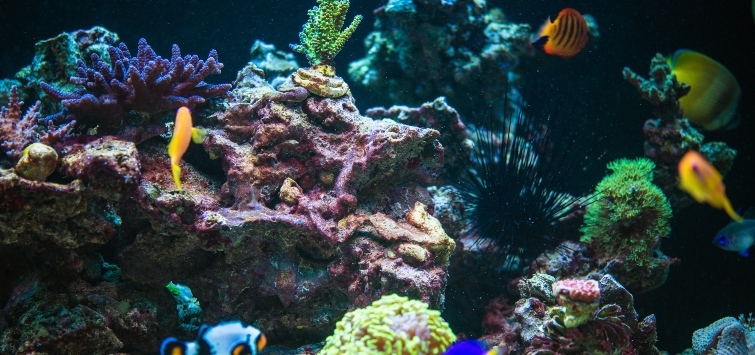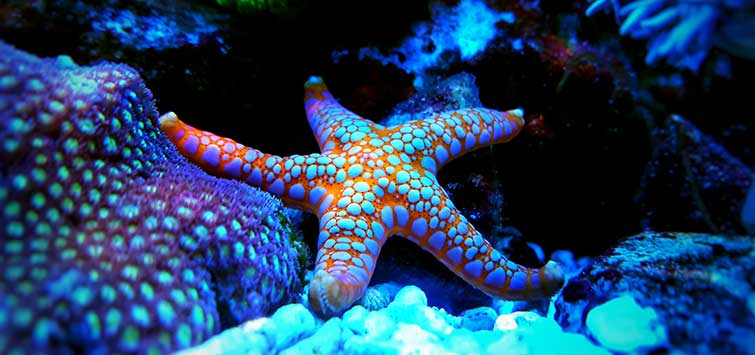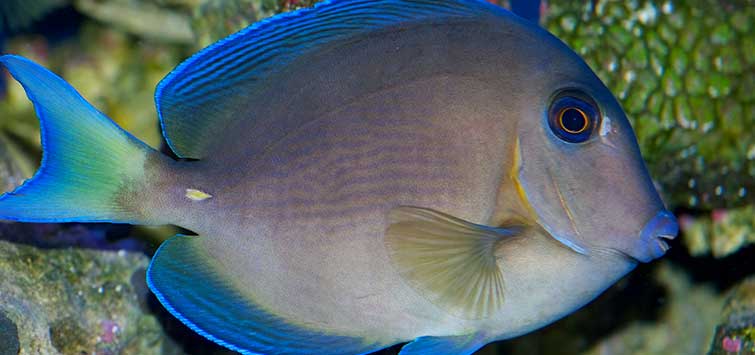Rockwork in the Reef Aquarium: A How-To Guide
Author: James W. Fatherree
How rockwork is laid out and arranged affects much more than where the corals can be placed because those choices can limit how large coral colonies will grow. Rockwork can also provide hiding spaces and homes for various fish and motile invertebrates, it can strongly affect water flow throughout the aquarium, and its placement can make cleaning some of the glass panes either relatively easy or nearly impossible. Let’s go over a few things to think about before building the rockwork foundation.
Types of Rock
There are a few options when it comes to the rocks themselves. You can use live rock, base rock, and fake rock in any way you see fit. However, each type has its pros and cons.
Waves—especially during storms—can break away bits and pieces of a reef’s rock framework, as well as the branches of stony corals. These limestone chunks can then be further broken up, abraded by sand, worked on by various burrowing organisms, and colonized by other various living things. Such pieces can also be affected by water chemistry before and after being freed, and all this activity can dramatically change their appearances. As a result, we end up with chunks of what’s sold as live rock.
Any piece of decent-quality live rock will have a significant variety of microorganisms living on or in it, and most all will have at least some coverage by coralline algae, typically giving it a patchy purple, pink, or red appearance. But that’s about it for a large part of what you’ll see for sale these days. However, top-quality aquacultured live rock often has an impressive variety of life on it, sometimes including various types of macroalgae, sponges, tunicates, bryozoans, worms, clams, barnacles, brittle stars, urchins, anemones, and even corals. So live rock can obviously vary greatly in quality and what’s included when you buy it.
Live Rock
The pros of using live rock are that it has beneficial bacteria on and in it, that it is often covered with other organisms that improve its appearance, and that it simply looks natural in form. The cons are that it can be terribly expensive, and it is sold by the pound, which can add up to a heck of a lot for rocks going into an aquarium.
Base Rock
On the other hand, there’s base rock, which is basically the same thing as live rock except that there’s typically nothing at all living on or in it when it’s purchased. In fact, it’s most often sold dry. The pros are that it still looks natural in form and that it’s much cheaper by the pound. Of course, the con is that there’s nothing on it.
Fake Rock
Then there’s fake rock, which is typically made of ceramic material or a mixture of aragonite sand and cement, and it can be made in whatever shape the creator chooses. Some of the stuff I’ve seen has outstanding form and looks so much like real rock that it’s hard to tell the difference. Additionally, some available pieces are produced specifically to cover overflow/corner boxes.
However, a lot of it looks quite unnatural, with odd forms and oftentimes with thick branches topped with pedestals. Of course, beauty is in the eye of the beholder. Regardless, the pros are that it can be made into natural or specific forms to suit personal preferences, and the con is (once again) price. It can be quite expensive, although it can vary greatly in cost.
While I’ve used some fake rock and been happy with it, it was costly. Because of this, I’ve set up most aquariums primarily with base rock and a few pieces of live rock mixed in to add some life to the overall appearance. Typically, a lot of the rockwork in a reef aquarium can’t be seen well, and things usually spread relatively quickly from pieces of live rock to base rock anyway. If I had to guess, I’d say most of the aquariums that I’ve set up were something like two-thirds base rock and one-third high-quality live rock, although I have set up a couple with nothing but base rock in the last few years. It gets better and better looking over time, but this method does take some patience.
Types of Arrangements
Rock Wall
When it comes to arranging rocks, there are a few basic styles. For decades, the most common one has been what’s best known as the rock wall. This is created by packing rocks in all the way across the aquarium from end pane to end pane, and then sloping from near the front pane at the bottom of the tank up toward the back pane. It’s the easiest way to stack up rocks as long as you have plenty of pieces, and it also provides a lot of area on which to place corals. However, making a wall can require quite a lot of rock, depending on the size of the tank.
Vertical Stacking
As a modification of the wall, rocks can still be stacked in a sloping or vertical manner but not from end to end. In this case, the rockwork also generally slopes toward the ends rather than just the front. This opens up the ends of the tank and allows for better viewing from there. Though this arrangement requires a lot less rocks than building a wall, it also reduces the amount of available space where corals can be placed.
Opposite Ends
Unlike these two styles, rockwork structures can also be built up at opposite ends of a tank, with the middle area left bare or occupied by a smaller pile of rocks. This opens up an aquarium aesthetically and requires much less rock. However, it also further limits the amount of space where corals can be placed. If done right, large corals (or corals that will grow to large sizes) can be placed in a manner that allows them to grow toward and into the open space, which can fill it to some degree for quite a nice look.
Bommie-like Rockwork Structures
Finally, I’ve seen more and more hobbyists using well-spaced bommie-like rockwork structures. These are typically rather tall and have a relatively small footprint, being larger vertically than horizontally. Again, this can look great if done well and spaced in an aesthetically pleasing manner, but it even further diminishes the amount of area that can be used for coral placement.
Make Good Selections
As mentioned previously, good selection and placement of corals that get big on such structures can look very attractive. This style will require the least amount of rocks to build, too. Cleverly arranged rock slabs can also be incorporated in these structures to create some nice overhangs for a different look. A few pieces of branching rock (which is really just pieces of branching coral skeleton) can really add to this arrangement—or any of the aforementioned styles.
Piecing It Together
When creating a structure from a bunch of rocks, there are a few important things to consider. These include the size of the individual pieces, how much open space can be created, and the stability of the structure.
In general, it’s best to create a base made of the biggest pieces of rock that will work for the style you choose and then build upward from there. Depending on the situation and the shape of available rocks, it is often possible to use only relatively large pieces for the entire structure, which typically looks best. However, it can be difficult to get big pieces to stack up well in a manner that appears natural and is aesthetically pleasing. In general, larger pieces are placed at the bottom, and then smaller pieces are used to build the structure upward.
That said, building structures using a higher quantity of relatively small pieces of rock typically looks less appealing, can be harder to build, and also requires more rocks. I think it’s best to spend some time looking over as many pieces—and using the greatest number of big pieces—as possible to get an idea of how they can be arranged together.
Stacking
When it comes to stacking the pieces, it’s critical that the structure is stable and won’t topple or suffer from something like a rockwork avalanche. You can roll each piece around and try various angles and configurations for a while until everything fits into place. Sometimes it’s actually pretty easy to get pieces to come together well, but be aware that getting everything just right can also take quite a while and may be downright frustrating at times.
Fortification
Also note that, if needed, a few non-rock materials can be used to help secure structures. Putty-like, aquarium-safe underwater epoxy sets as hard as rock and can be used to help lock pieces in place when they just don’t want to solidly stay put. Plastic screws of various sorts, and even acrylic rods or PVC pipe, can be used too.
Drilling
Fortunately, limestone rock usually isn’t very hard as far as rocks go, and a hand drill with regular drill bits can typically be used to make holes for screwing pieces together. Some live rock and base rock can be quite dense and hard; for this, a masonry bit and some extra elbow grease may be required.
Likewise, in the case of building bommie-like structures, you can keep rocks stacked by drilling a hole all the way through each piece and inserting a large-diameter acrylic rod or piece of heavy PVC pipe through them to hold them vertically in place. Doing so can obviously take significant planning and some extra effort, but when done right the results are exceptional.
Rock on Glass
I’ll also add that I don’t like having rocks in direct contact with the bottom pane of glass, especially big pieces. Many rocks have knobs and pointy edges, and these can create pressure points on the glass. In other words, a large rock with a lot of other rock stacked on top of it may only make direct contact with the glass at a few small points on its underside.
As a result, all of that weight is concentrated on those few points instead of being spread out, which could lead to a catastrophe. Before putting any rocks in a tank, it’s a good idea to first add enough sand to keep them from actually touching the underlying glass, which helps evenly distribute their weight.
The Space Between
There are a few more aspects of reef construction to consider, with the first being spaces. As I just mentioned, when rocks are stacked up, it’s good to create or leave a lot of spaces. For one, almost all fish and many other critters will be happier in an aquarium if there are plenty of gaps, holes, and crevices in the rockwork in which they can hang out, hide, and sleep. This is especially true if there are any relatively aggressive fish housed with less aggressive ones.
Spaces between rocks also leave more room for water to move through the rockwork, and that also helps to keep down the accumulation of detritus within it. Likewise, having open space in the aquarium around the rockwork helps with overall water flow.
And finally, there’s the glass to think about. Building a rock wall or a pile of rocks at both ends of a tank means that you won’t be able to clean the glass there when it gets dirty. You either have to get used to looking at some unclean glass on the ends or refrain from stacking rocks so close to the glass that you can’t get to it with a cleaning device of some sort. That’s why I try to leave just enough room at the ends of the rockwork to slide a magnet cleaner in between the rocks and the glass.
A Reef of Your Own
Reef building isn’t nearly as complex as the look of a mature reef suggests; once you determine the type of rock and arrangement style you want, the rest is a matter of stacking, securing, and supporting the structure in the tank. Before long, you’ll have a thriving reef aquarium to stock and enjoy in your own home.

.png?h=595&iar=0&w=2781&hash=5FD5E69473BCC22199FBFA2FB71B6033)



